Shep Hyken's Blog, page 170
April 19, 2017
Coffee, Tea or Laptop?
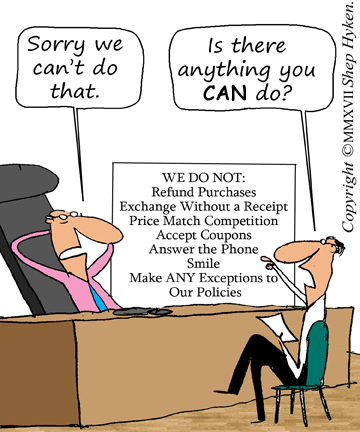 Last week was a bad week for the airlines. The United Airlines customer service debacle hurt all airlines, not just the United brand. It’s not uncommon for flights to be overbooked, delayed and cancelled. Passengers get angry. Airline personnel get angry. “Travel hassle” can be very stressful on everybody.
Last week was a bad week for the airlines. The United Airlines customer service debacle hurt all airlines, not just the United brand. It’s not uncommon for flights to be overbooked, delayed and cancelled. Passengers get angry. Airline personnel get angry. “Travel hassle” can be very stressful on everybody.
I love it when I take a flight that is on time. And, I love it even more when the flight attendants on those flights understand that after their number one priority, which is safety, their second job is to be brand ambassadors for the airline they represent. And, that goes for all other airline personnel. By the way, that’s a pretty good way to operate any type of business.
So, with all the negative press surrounding United Airlines, I thought that sharing some good news about another airline might be a breath of fresh air. This great story starts with some bad news that was out of the airline’s control. It was recently announced that airlines flying from certain countries would have to collect from passengers any electronics larger than a cell phone. That means business people can’t bring their laptops on board. Families can’t bring iPads or other tablet PC’s that might have movies and games to keep their children occupied on these long international flights.
Let me emphasize that this is not the airlines fault. This ban on electronics is a United States of America policy. I’m not going to go into the ways this could negatively impact airline financials, but that’s a big concern. What can an airline do?
Well, Qatar Airline, which operates out of Doha, Qatar, one of the countries that is part of the electronics ban, is trying to make some lemonade out of lemons. While not a total fix, they have a way to ease some of the pain. They are providing “loaner laptops” to all business and first class passengers. In addition, all passengers get at least one hour of free WIFI. And, for just $5.00, passengers can have WiFi for the entire flight.
So, here is the lesson: Every company must stay within the law. Some industries are heavily regulated and must adhere to compliance and tough rules that they have no control over, and many of these rules or laws are not customer friendly.
So, when faced with a government-imposed regulation, or even a tough company policy, what can you do, like Qatar Airlines has done, to comply, but still make it easier on your customers?
Brainstorm the question with your employees. Consider all answers, from the ridiculous to the realistic. Somewhere in between you’ll find your version of the “loaner laptops.”
Shep Hyken is a customer service expert, keynote speaker and New York Times bestselling business author. For information contact or www.hyken.com. For information on The Customer Focus™ customer service training programs go to www.thecustomerfocus.com. Follow on Twitter: @Hyken
(Copyright © MMXVII, Shep Hyken)
Save
Save
Save
The post Coffee, Tea or Laptop? appeared first on Shep Hyken.
April 18, 2017
Amazing Business Radio: Amy Downs
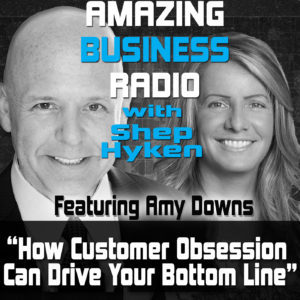
Amy Downs on How Customer Obsession Can Drive Your Bottom Line
Are you obsessing about taking care of your customers? If not, maybe you should!
Shep Hyken interviews Amy Downs, Chief Customer Success and Happiness Officer at Lifesize, a connected video conferencing company, about why you should be obsessed about taking care of your customers.
First Up:
Shep Hyken’s opening comments focus on April being customer loyalty month. Customer loyalty should be a year-round focus, and not just a monthly effort, but let’s take this month to celebrate. We need to obsess about creating such an amazing customer experience that our customers will want to do business with us and nobody else.
When Shep talks about creating an amazing customer experience, it’s important to remember that amazement is not always an over-the-top, blow-me-away, most incredible service you have ever had type of experience. It is more about consistently and predictably being just a little above average. Consistency is the key word. That’s the hard part. That’s what the best companies in the world do. They execute their service consistently.
Further to the point, any company that decides they want to obsess over their customers has an opportunity to not just have a transaction, but to build a relationship. At the end of the day, all things being equal, what tips the scale in that company’s favor, is the relationship.
Featured Interview:
Shep begins his interview by asking Amy Downs what does it mean to be customer obsessed? Amy responds by saying that Lifesize has four core values, and that customer obsession is number one. Many companies talk about “treating customers great,” but you must make sure that you have the right people on board. People with customer service DNA and customer service hearts. Then you must have the right systems and processes in place that allow these employees the ability to understand what is important to your customers.
Top Takeaways:
Customer obsession can be the foundation for growth in your business. Amy stressed the importance of customer retention. You can link an increase in customer retention or a decrease in churn directly to the overall bottom line. If you lose a customer, it is usually very hard to get them back. The easiest customer to sell is the one that you already have. Regardless of what industry you are in, your customers are talking to each other and to other potential customers. When word of mouth starts getting out there, you start to better references and referrals that convert to customers at a much higher rate than traditional marketing.
How you can know that your customer obsession efforts are paying off. Amy said there are a lot of data analytics that they use to help understand the relationship they have with each of their customers. It is important to capture both qualitative and quantitative data to determine how you are doing in your relationships. For example, with quantitative data you can examine Net Promoter Scores as well as churn rates.
Best tips on how to become customer obsessed. Amy suggests to set a strategy and educate your people. Everyone in the company must understand the importance of building a customer-best company and how it impacts the bottom line. Continually share with them the results of the positive change in your customers’ lives, so that they can feel proud of the work they do. Be sure to make course corrections when needed, but do them in a super positive way. The front-line employees are the most critical piece of any business, but ensure that you are listening to all of your employees. Create an environment and a culture where employees can thrive, and where they’re empowered to drive change on behalf of customers. This can help reinvent a business. And, this helps people to feel like they have a much greater purpose in they work they do.
About:
Amy Downs joined Lifesize in 2014 to evangelize the importance of customers throughout the organization, and ensure that everyone who interacts with the company has a smile on their face. From support, service, training, and renewals; Amy drives the strategy and execution of programs that benefit their customers and partners to bring successful video collaboration to their companies.
Shep Hyken is a customer service and experience expert , best-selling author and your host of Amazing Business Radio.
“You can’t just tell an employee something once. You must continue to educate and to communicate that information.” – Amy Downs
This episode of Amazing Business Radio with Shep Hyken answers the following questions … and more:
What are the benefits of being customer obsessed?
Why is referral marketing better than traditional marketing?
Why is Word-of-Mouth marketing so effective?
How do you become customer obsessed?
How can you use data analytics to proactively address customer service issues?
Save
Save
The post Amazing Business Radio: Amy Downs appeared first on Shep Hyken.
April 17, 2017
5 Top Customer Service Articles For the Week of April 17, 2017
Each week I read a number of customer service articles from various online resources. Here are my top five picks from last week. I have added my comment about each article and would like to hear what you think too.
Getting More Referrals = Letting People Your Customers Care About Know About Brands That Care About Them by Joseph Michelli
(Joseph Michelli) Here are some broad approaches to activating promoter behavior in your loyal customer base.
My Comment: If you want more referrals, then make it easy for your customers to give you referrals. Bestselling author and business expert, Joseph Michelli, shares five important basics that you must consider if you want those sought-after customer referrals.
How to Drive Customer Loyalty Among Millennials by Timi Garai
(Emarsys) Loyalty needs to be fun. At least 60% of millennials seem to think so, but how can you best meet this expectation alongside all their other demands?
My Comment: No doubt that there are generational differences in the way customers like to buy and expect to be serviced. This excellent article has several ways to drive loyalty with millennials. They want to identify with the brands they do business with, and treated right, they will share their experiences with others on social networks.
Knowing the Difference Between Loyalty and Retention Programs by Keith O’Brien
(DMN News) The term loyalty has typically been used as a catchall to describe any program that customers can opt into to get some sort of rewards. The simplest of these programs is the famous punch card where ten purchases get you a discount or free purchase once completed.
My Comment: There is a difference between a customer loyalty program and a customer retention program. Do not confuse the two. A repeat customer may not be a loyal customer. The goal of saving a defecting customer isn’t about making them loyal. It’s about getting them back for a chance to potentially make them loyal. If customer loyalty is important to your business (and you know it is), you will definitely enjoy this article!
Brands this is what can happen on Twitter when you get it spot on by Mark Shaw
(Mark Shaw) Every now and then a brand gets it spot on. In this case it is @wendys On the 6th April a student called Carter Wilkerson aka @carterjwm sent this tweet to Wendys.
My Comment: Many brands track social media posts to respond to complaints and customer support issues. However, the best brands know to respond to every post, not just complaints. The way Wendy’s, the restaurant chain, responded to a recent tweet is a perfect example of what happens when companies do social media the right way. Sometimes you hit, as the author says, a “marketing jackpot.”
United Airlines and the Dollars and Cents of Customer Experience by Augie Ray
(WHICH-50) But at the end of the day, will this damage United’s business as some claim? The answer is no and yes and, this is a customer experience lesson for business leaders.
My Comment: I couldn’t let this week’s Top Five list get away without at least one article about the United Airlines Customer Service debacle. It’s not about what happened (It was awful!), but what we can learn from what happened. Social media gives customers a loud voice and a huge platform. This article points out some very important lessons about how every business must embrace and understand the power of social media.
Shep Hyken is a customer service expert, professional speaker and New York Times bestselling business author. For information contact or www.hyken.com . For information on The Customer Focus™ customer service training programs go to www.thecustomerfocus.com . Follow on Twitter: @Hyken
Save
Save
Save
Save
Save
Save
Save
The post 5 Top Customer Service Articles For the Week of April 17, 2017 appeared first on Shep Hyken.
April 14, 2017
Guest Blog: The Future of CX Lies with Humans Not Robots
This week on our Friends on Friday guest blog post my colleague, Jaime Scott, writes about how engagement is crucial to delivering an excellent customer service experience. Remember that engaged employees work harder, care more about the company, the people they work with and ultimately care more about the customer. – Shep Hyken
Plagued by rising costs, employee churn, absenteeism and declining standards, contact centers across the world are facing a combination of challenges unprecedented in the 50-year history of the industry.
Many have turned to digital channels in an attempt to find a solution, but have discovered to their cost that automation alone doesn’t hold the answers.
The reason for this is that as technology makes contact centers more efficient, (by taking over the simplistic tasks), it will lead to a requirement for more capable agents; who will be needed both when technology is unable to solve complex challenges, and when it simply fails altogether.
What this serves to demonstrate is that ultimately organizations will depend more on human creativity, not less.
So, while the rise of automation is inevitable, there is a rock-solid case for investing in people and employee engagement, as it’s humans who have the intuition, people skills, creativity, and complex problem-solving abilities that are essential to deliver a first-class CX.
And for those who are hell bent on going digital, it’s worth pointing out that even if a digital CX program is successfully implemented, it will only serve to deliver standardization across the sector. How can you possibly offer a competitive advantage based on superior CX when it looks and responds just like everyone else?
Workforce Engagement Management is absolutely crucial to the success of CX.
We have already witnessed the rise of technology with performance metrics and targets in the name of Workforce Optimization. This obsession with monitoring software has resulted in a tendency to focus on the data, and then drill these numbers into an agent’s psyche, day after day after day.
Ironically the technology currently employed is treating agents like robots, which is why you get a robot-like mentality in return. Under pressure, unmotivated, maligned by the general public; and people wonder why agent disengagement is now at epidemic levels.
It is now an inescapable requirement that contact centers introduce management and motivational tools that can nurture a new generation of super-agent; engaged, informed, enthused and capable of delivering a superior CX.
Engagement isn’t just about keeping people focused on their day-to-day workload. 21st-century engagement is a sense of organizational connection and relevance, it’s an understanding of purpose, of contribution and the opportunity to learn and progress.
Workforce Engagement Management (WEM) is fast becoming an imperative for the future health, prosperity and even the very survival of many contact centers.
Without it, you might as well employ a bunch of robots.
To learn more about WEM, and how it is revolutionizing the industry, visit EvaluAgent, download the manifesto or if you would like to see it in action, request a demo.
Jaime Scott is CEO of EvaluAgent and leads the team in delivering people-focused software and services to its growing client list. After almost twenty years directing customer experience and workforce engagement programs for some of the UK’s biggest brands, including EE, Barclays and M&S, Jaime’s mission is to empower contact centers to deliver a superior CX.
For more articles from Shep Hyken and his guest contributors go to customerserviceblog.com.
Read Shep’s latest Forbes Article: How To Create A ‘We’ve Been Expecting You’ Service Experience
Save
The post Guest Blog: The Future of CX Lies with Humans Not Robots appeared first on Shep Hyken.
April 12, 2017
Lose the Customer’s Confidence and You Lose the Customer
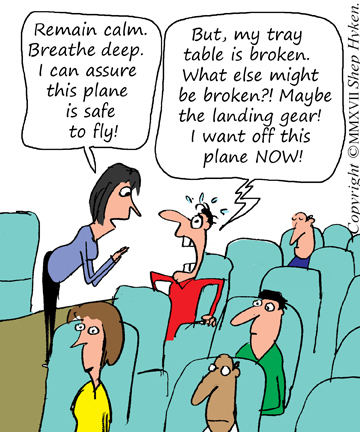 My wife and I were on the phone with our bank. They take care of our checking accounts and credit cards for our entire family, and we were having a problem transferring money from one account to another.
My wife and I were on the phone with our bank. They take care of our checking accounts and credit cards for our entire family, and we were having a problem transferring money from one account to another.
The frustration began with fifteen minutes of hold time. Once the customer service representative came on the call, Cindy briefly described the problem. The rep asked a number of security questions, which included her full name, address, where she was born, mother’s maiden name, social security number and driver’s license number. While more than the usual questions, I understand they are for our protection. That said, the entire interaction, including fifteen minutes spent on hold waiting for the rep, was now approaching twenty minutes and thus far nothing had been resolved.
At the end of the “interrogation,” the bank’s rep said he didn’t have what he needed to verify Cindy’s identity, and he was transferring her to another rep. What do you think happened when the new customer service rep came on? She asked the same questions.
It’s now been almost 30 minutes and the reason for the call has not yet been addressed. We asked to speak to a supervisor. After a few more minutes on hold another agent picked up. Calm, cool and definitely more knowledgeable than the last two support reps, he resolved the problem … in under six minutes. He was able to take a look at several of our accounts and discovered why we were having our problem, and he fixed it.
So, let’s look at the numbers. Total time on the phone was 47 minutes. Total time to get to a person that was capable of resolving the problem was 41 minutes. And, I’ll categorize that 41 minutes as a waste of time, never to be recaptured. 41 minutes of our life gone due to long hold times and two customer service reps who were not properly trained or had not been empowered with the authority to get the job done.
So, what was the cost to the bank? I’m not sure what they pay their people, but there was wasted payroll when the first two support reps couldn’t answer my question. But what is the big cost? Shattered customer confidence.
Even though our last customer service rep got the job done, the other two couldn’t. 87% of the interaction was on hold or talking to people who couldn’t help us, which made us frustrated, if not downright angry at the bank. After the call, we had a short conversation about switching banks. We chose to give them one more chance, but will a similar experience in the future push us to find a new bank? How many positive interactions will we need to have to forget this debacle and have our confidence in the bank’s customer service restored to normal?
In today’s competitive business environment, a company can’t afford to lose a customer’s confidence. Maybe the customer will give the company a second, or even a third chance. A bank is “sticky,” meaning it’s not easy to close an account at one bank and open a new one at another. It takes time and effort. It’s not like deciding to buy shoes at a different department store. Every employee who comes into contact with a customer must recognize that in addition to the job they were hired to do, they are also there to create confidence. Here’s the bottom line: Lose the customer’s confidence, and you will lose the customer.
Shep Hyken is a customer service expert, keynote speaker and New York Times bestselling business author. For information contact or www.hyken.com. For information on The Customer Focus™ customer service training programs go to www.thecustomerfocus.com. Follow on Twitter: @Hyken
(Copyright © MMXVII, Shep Hyken)
Save
Save
The post Lose the Customer’s Confidence and You Lose the Customer appeared first on Shep Hyken.
April 11, 2017
Amazing Business Radio: Adam Dorrell

Adam Dorrell on How to Monetize the Net Promoter Score
How do you use the Net Promoter Score® to retain your customers? How can you make money by understanding the numbers behind this survey? How can you sell the C-Suite on the benefits of investing in Customer Retention?
Shep Hyken interviews Adam Dorrell, the CEO and co-founder of CustomerGauge.
First Up:
Shep Hyken’s opening comments focus on the Net Promoter Score®, which is the result of a survey question that asks a customer “How likely would you be to recommend us?” Shep feels that NPS is one of the simplest, yet most powerful feedback measurement tools. However, according to the annual Net Promoter Score® benchmark survey from 2016, it was found that 90 percent of the companies were not clear if, after implementing their Net Promoter Score® program, whether they had increased customer retention. The score is nice to know, but what does it mean to your business?
Featured Interview:
Shep begins his interview with Adam Dorrell by discussing the Net Promoter Score® Benchmarks, The Annual Survey, which discusses the latest in the Net Promoter® industry, best practices, and recently added company scores.
CRM software tools have been around for about 30 years, but these tools are about the acquisition of a customer, not so much about the maintenance or retention of a customer.
Adam said that about 40 percent of survey respondents were not sure how much business they retain each year.
The average retention number for companies is about 80 percent, so the average American business loses 20 percent of their customers every year.
Top Takeaways:
A repeat customer will do more business with you than a new customer. Repeat customers spend more.
The CEO and leadership team must buy in to the power of the NPS measurement and approve a budget for customer experience and retention. Success must be measured with proper KPI’s.
Customer feedback should be responded to in a timely matter. Too often companies push the survey out once a year and then take three months to process the feedback. By then it’s too late to properly respond to the customer.
Low scores require attention in a timely manner. Dorrell recommends focusing on detractors first, typically within 48 hours. Find out why the customer scored the company low and what the company can do to retain the customer. Beyond trying to “save” the customer, use the feedback to eliminate the same issues from happening to other customers.
High scores are also worth responding to. Find out the “why” behind the score. Your promoters are gold and will share information that can help create an even better customer experience.
About:
Adam Dorrell started CustomerGauge in 2008 to help companies solve the problem of retaining customers. Compatible with the Net Promoter Score®, CustomerGauge allows organizations to improve customer relationships and encourage loyalty, most immediately in e-commerce functions.
Shep Hyken is a customer service and experience expert , best-selling author and your host of Amazing Business Radio.
“Some companies (we call them NPS Leaders) are doing things right. Not only do they measure, but they also act on customer feedback in a timely manner, and grow by using referrals and social reviews.” – Adam Dorrell
This episode of Amazing Business Radio with Shep Hyken answers the following questions … and more:
How can you retain more customers and get more referrals?
Why should I use NPS to measure customer satisfaction?
How can I determine the ROI for customer experience and customer retention programs?
Why don’t more companies measure customer satisfaction?
How can we monetize Net Promoter Score?
Should I focus on my detractors or my promoters first?
Save
Save
Save
The post Amazing Business Radio: Adam Dorrell appeared first on Shep Hyken.
April 10, 2017
5 Top Customer Service Articles For the Week of April 10, 2017
Each week I read a number of customer service articles from various online resources. Here are my top five picks from last week. I have added my comment about each article and would like to hear what you think too.
Improving Customer Experience Through Customer Data by Daniel Newman
(Forbes) By using advanced analytics, companies can make better use of their customer and user experiences, leading to higher satisfaction — and loyalty — in the long term.
My Comment: This short article showcases the growing trend of personalizing a customer’s experience. People like doing business with companies that know them. And, this doesn’t happen by accident. Companies are embracing customer data as a purposeful way to deliver a personalized experience, which can lead to repeat business. In addition, customer data gives you more insight into trends, what’s working, what’s not and more.
eBook The Definitive Guide to Storytelling in Business: A how to guide in rising above the noise and making an impact by Matthew Woodget
(Go Narrative) A convenient, clear guide to help you use storytelling for your business.
My Comment: While it falls into the category of marketing over customer service or customer experience, I couldn’t resist sharing this very interesting report (ebook) on storytelling for business. You most likely have heard the Nordstrom story of the customer returning a set of tires. That story has served Nordstrom well in a number of ways, including putting them on the map as one of the most customer focused companies on the planet. So, what’s your story, and how do you find it? This guide by Matthew Woodget will get you started.
The cost of NOT focusing on Customer Experience by Ian Golding
(I J Golding) In reality, whilst many senior leaders are still not quite believing of the financial benefits of a CX focused strategy, most of them work in organisations which are suffering remarkably demonstrably from NOT having one!
My Comment: How much does it cost to deliver a better customer service experience? Perhaps the question should be how much does it cost if you don’t? This short article makes the case for paying attention to the customer experience, because if you don’t, it can cost you your business.
Stop Wasting Your Money on Customer Experience by Jon Picoult
(Carrier Management) Faced with increasingly commoditized markets, more and more insurers are launching customer experience improvement programs to differentiate themselves. However, there’s something many of these companies don’t yet realize: The vast majority of their programs will fail.
My Comment: Reading the title of this article might make you think that investing in customer experience could be a waste of money. Not true! It’s more than creating a budget for customer experience. It’s more than just spending money. This article makes the case that NOT caring about customer experience the right way is a waste of money.
Omni-Channel & Single Customer View Statistics by Sharpen
(Sharpen) Customers are increasingly more likely to be disloyal following high-effort experiences. And unfortunately, these experiences are common.
My Comment: Did you know that 84% of US consumers used web and mobile for help? (Customer want and expect you to have a self-service solution.) That’s just one of many insightful stats and facts that our friends at Sharpen have compiled.
Shep Hyken is a customer service expert, professional speaker and New York Times bestselling business author. For information contact or www.hyken.com . For information on The Customer Focus™ customer service training programs go to www.thecustomerfocus.com . Follow on Twitter: @Hyken
Save
Save
The post 5 Top Customer Service Articles For the Week of April 10, 2017 appeared first on Shep Hyken.
April 7, 2017
Guest Blog: 4 Things to Learn from a Disappointed Customer
This week on our Friends on Friday guest blog post my colleague, Swati Kungwani, writes about the value of customer complaints to a business. Complaints are opportunities to show how good you can be. – Shep Hyken
Treasure the learnings to maximize business earnings!
Disappointments can be delightful! The way you look at the issues can make a huge difference in resolving them. Customer behavior is becoming more dynamic. Their demands are ever-increasing owing to the influence of Internet. Every organization is facing a stern competition to sustain their business growth. According to the reports,
“It is in the hands of the companies to prevent 85% of the customer churn caused due to futile poor service.”
Customers tend to grumble or express their discontent if things go wrong. But, not all would come back to the organization stating their grievances. They’d rather choose to quit and switch to something else. The customers making a complaint are actually expecting a solution. A company should make provision to address their dissatisfaction. Next, they should make efforts to continue their valued association.
It is useful to consider customer complaints in framing your service policies. Incorporate following four points in your CRM strategy to learn from mistakes:
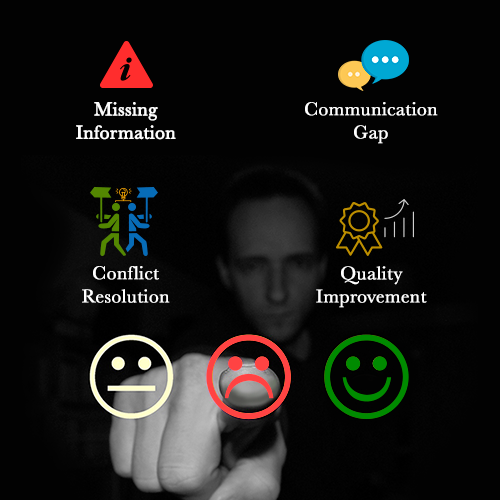
Missing or misleading information
Are you marketing your product in the right way?
In the race to winning the customers or the aimed targets, things are often overpromised. It is important to design a good product. Also, it is significant to market and sell in the right way. It is always pleasing to under-promise and over-deliver. The opposite scenario is never acceptable. An unhappy customer shows you the actual scenario of the market. The company can then advertise and sell their products as per the market needs.
Communication gap
What actions should a company take at an internal level?
Communication is essential. A company should always achieve clear and active communication at all levels. Customer complaints highlight the missing elements of internal and external relations. It assists you to analyze the ideal way to do things. Complaints give the insights to what is lacking within the current processes. Also, it helps you to build a bridge to channel things in the system. Streamline all the business processes and departments in a unified manner.
Conflict resolution
Do you have a standard approach to provide customer support?
In essence, customer complaints are the greatest business opportunities. A quick tip is to examine the negative feedback. Plan to work on turning the complaints into positive relations. A standard conflict resolution platform automates the process of managing complaints. Also, trained customer service team ensures the best care at the right time. An ideal support mechanism can be the game changer for your business!
Scope of Improvement
How to devise the future plans?
An unhappy customer is the source of new possibilities. It helps you with improvising the quality of service and fixing the cessations. Avoid facing similar complaints in the future and losing other customers. Focus and solve their issues with attention, and design a long-term strategy. Figure out common problems, unnoticed concerns and disregarded matters. Trace the matters that are important for the customers, if not for the company. Prepare a road-map for a successful future.
Globally, people are using their smartphones and online channels to communicate their voices. A company should also use technology services to map successful customer journeys. New-age software solutions and mobile apps offer a wide range of benefits. The support platform reduces the cost of operations and increases employee engagement. It lets you be available and accessible to your user base. Do not ever forget to remember your customers!
Swati Kungwani is the content manager for iTouchVision. She specializes in the B2B customer experience management and has been with iTouchVision, driving new customer initiatives to promote business activities.
For more articles from Shep Hyken and his guest contributors go to customerserviceblog.com.
Read Shep’s latest Forbes Article: Are You Part Of The $62 Billion Loss Due To Poor Customer Service?
Save
Save
Save
Save
The post Guest Blog: 4 Things to Learn from a Disappointed Customer appeared first on Shep Hyken.
April 5, 2017
Don’t Put the Onus on the Customer
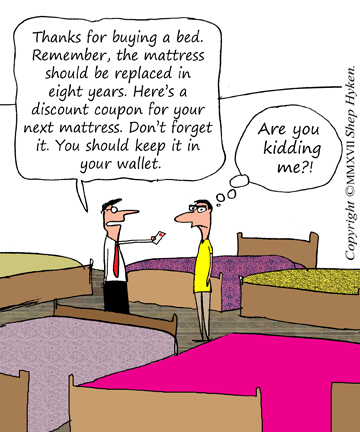 One of our faithful Shepard Letter subscribers, Warren Danziger, emailed a great story worth sharing with everyone. The short version of the story is as follows:
One of our faithful Shepard Letter subscribers, Warren Danziger, emailed a great story worth sharing with everyone. The short version of the story is as follows:
It was time to call the HVAC company that Warren had used for years to come out for the semi-annual inspection of his air conditioner and furnace. As usual, he received excellent service. Shortly after the service call he received an email requesting he complete a survey, which he was happy to do. Upon completion of the survey he was sent a $15 coupon to print out for the next service call, which he must provide at the time of the next service.
Warren’s reply sums up this lesson, quite well:
Thank you for the coupon. Why is the onus on me to save the coupon for 6 months and to remember to present it to the repair person? If you really mean it, make a note in your computer file and automatically deduct it from my next service call.
Way to go, Warren! He recognized a friction point that the company may or may not have be aware of.
Now, there may be some cynical people in the world that might say the company purposely makes the customer hold onto the coupon for six months, knowing the customer will forget about it or lose it and it won’t be redeemed. However, I don’t think that was the company’s intent. They just wanted to show some generosity and appreciation. Warren recognized there was a better way to do it. What the HVAC company could have done was sent the coupon with something similar to the following explanation:
You are welcome to print out the coupon, but save a tree and don’t worry about it. We’ll remember to apply it to the next service call. Thank you again for your business!
This is a powerful customer service lesson. There are many times companies think they are doing right by the customer, but in reality, they could be causing an inconvenience. So, analyze the process you put the customer through while they are doing business with you. What onus do you put on the customer? Even a slight inconvenience is worth discussing with your team to determine how to mitigate or even eliminate the friction.
Customer service is a differentiator. And, it’s more than just being nice, friendly and helpful. The people side of the business builds a connection with the customer. That is and always will be important. And, what is happening in today’s environment is that the customer also wants a better experience. And, part of that experience is convenience. You must make it easy to do business with you. Take great people skills and combine them with an easy and frictionless experience, and you will have a combination that is hard to beat.
Shep Hyken is a customer service expert, keynote speaker and New York Times bestselling business author. For information contact or www.hyken.com. For information on The Customer Focus™ customer service training programs go to www.thecustomerfocus.com. Follow on Twitter: @Hyken
(Copyright © MMXVII, Shep Hyken)
Save
Save
Save
The post Don’t Put the Onus on the Customer appeared first on Shep Hyken.
April 4, 2017
Amazing Business Radio: Jeff Toister
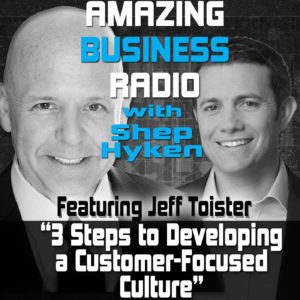
Jeff Toister Provides 3 Steps to Developing a Customer-Focused Culture
Nearly every company says that they want to have a customer-focused culture, but then why are so many companies lacking one? What are the steps that your company needs to take to be committed to becoming customer focused?
Shep Hyken speaks with Jeff Toister about his new book, The Service Culture Handbook: A Step-by-Step Guide to Getting Your Employees Obsessed with Customer Service.
First Up:
Shep Hyken’s opening comments focus on how the best companies have an amazing service culture, because they have an amazing culture. Period.
For instance, Zappos has their Ten Core Principles on how to create that customer-focused culture. CEO Tony Hsieh has even been known to fire employees if they can only buy into nine of the ten principles. Tony doesn’t even particularly care if his employees like shoes, but he is adamant that all his employees fit into the culture.
The culture starts on the inside and is felt on the outside by the customer. If a company has a good customer-focused culture, there is a pretty good chance that the company has a great internal culture. The companies known for providing the best customer service are typically the best companies to work for.
Featured Interview:
Shep begins his interview by asking Jeff Toister, “Why don’t more companies have a customer-focused culture?” Toister claims the challenge is that we simply don’t know how to get there. There is so much information about how to develop a customer-focused culture. Some of it lines up, and some of the information is conflicting. With so much conflicting advice, how can you make sense of it all? To help you to get there, Jeff Toister wrote his book as a guide that anyone could pick up and follow as a step-by-step plan to develop a customer-focused culture in their organization.
When you have finally achieved the goal of creating a customer-focused culture, you will find that your employees are absolutely obsessed with service. They know what they are supposed to be doing. They’re committed. And they always seem to do the right thing.
Top Takeaways:
Three steps to developing your customer-focused culture:
Define what your culture is going to be. Your customer service vision needs to be one sentence, that everyone can remember. It needs to focus on the customer, not that you will be “industry-leading” or will make a lot of money. It cannot be a fluffy statement that no one believes in, but it must become a way of life for everyone in the organization. Who are we on our best day? Example: In-And-Out Burger’s “Quality, Consistency, and Courtesy”
Engage your employees and get them committed. Employees must fully understand what makes the organization successful, and they are committed to achieving that success. Many organizations have a difficult time having their employees give a consistent answer as to what “success” means.
Align everything in your organization around that definition of success, that customer service vision. We tend to do things that create conflicts and, that make it harder for our employees to deliver outstanding customer service. For example, we focus on customer service survey scores, and reward or penalize employees accordingly. Instead, we should focus on the feedback and learn how to use it, so that we can continually improve and deliver even better customer service.
About:
Jeff Toister helps customer service teams unlock their hidden potential. He has authored customer service training videos on Lynda.com and was named one of the Top 30 customer service professionals in the world by Global Gurus. He was also named one of the Top 50 Thought Leaders to Follow on Twitter by the International Customer Management Institute. Jeff holds Certified Professional in Learning and Performance (CPLP) certification from the Association for Talent Development.
Shep Hyken is a customer service and experience expert , best-selling author and your host of Amazing Business Radio.
“Alignment says I need to focus on my customer service vision, not on the score.” – Jeff Toister
This episode of Amazing Business Radio with Shep Hyken answers the following questions … and more:
How do I get executive leadership to buy into customer service?
How do you create a customer service mantra?
What does engaging your employees mean?
What is ‘survey baiting’?
What sets customer-focused organizations apart?
How do I create a customer-focused culture?
How do you get employees obsessed with customer service?
Why do so many organizations struggle to consistently deliver amazing service?
Save
Save
Save
The post Amazing Business Radio: Jeff Toister appeared first on Shep Hyken.








